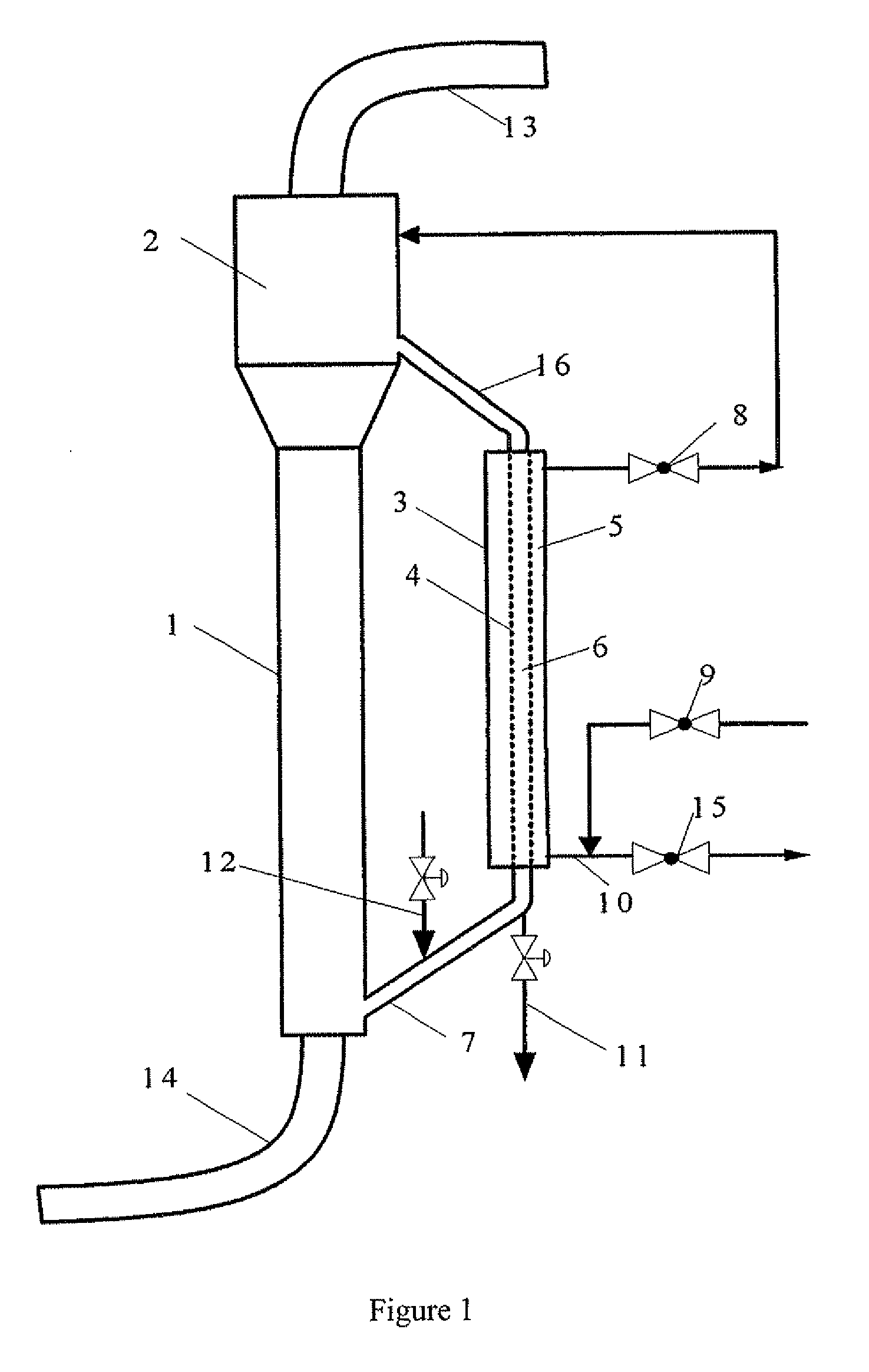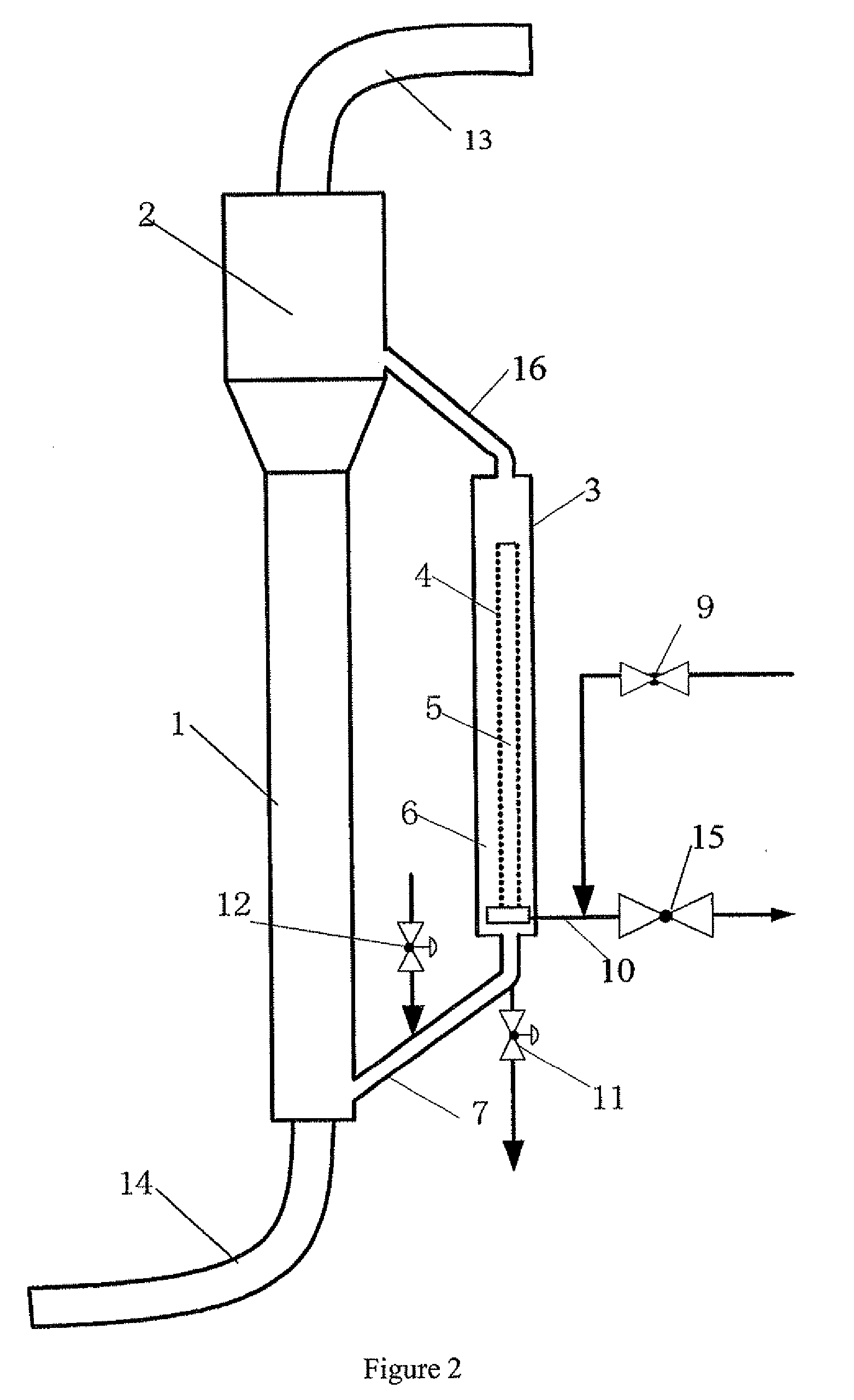Slurry bed loop reactor and use thereof
- Summary
- Abstract
- Description
- Claims
- Application Information
AI Technical Summary
Benefits of technology
Problems solved by technology
Method used
Image
Examples
example 1
[0050]The reactor as shown in FIG. 1 is used. The riser settling section (2) and the reaction section (1) in the slurry bed loop reactor have a tube diameter ratio of 1.5:1. The filter tube used in the downcomers is the sintered metal porous filter tube having an outer diameter of 50 mm, a length of 1,000 mm and an average pore diameter of 1 μm. The particle size of the catalyst used therein ranges from 1 to 100 μm. During such process, the synthetic gas enters the bed layer in a bubbling form from the bottom of the riser, and forms the liquid hydrocarbons under the operating conditions. After the slurry rises to the settling section, the unreacted synthetic gas and the gas product are completely separated from the slurry, and discharged from the outlet. Coarse catalyst particles (about 80% of the total amount of the catalyst) in the slurry settle down in the settling section and return to the riser. The slurry enters the filter tube of the downcomer, and the liquid product enters t...
example 2
[0053]The slurry bed loop reactor as shown in FIG. 1 is used. The riser settling section and the reaction section in the reactor have a tube diameter ratio of 1.5:1. The filter tube used in the downcomers is the sintered metal porous filter tube having an outer diameter of 50 mm, a length of 1,000 mm and an average pore diameter of 1 μm. The particle size of the catalyst used therein ranges from 1 to 100 μm. The raw material is the synthetic gas. When the differential pressure between the inner and outer tubes of the downcomer is higher than 0.5 MPa, the back purging system goes into operation. The product supernatant is introduced to the outer tube with a pump, and into the inner tube through the wall of the filter tube. The filter cake is purged to the slurry and flows downwardly along with the slurry to the riser. This process lasts several seconds. When the differential pressure between the inner and outer tubes is lower than 0.1 MPa, the back purging system closes, and the slur...
example 3
[0055]The reactor as shown in FIG. 9 is used. Said turbulence section (20) is separated from the steady flow section (19) by said cylindrical baffle, and the bottom of said steady flow section (19) is connected to the reaction section via the hole(s) at the bottom of the baffle. The reaction section has a size of Ø70×3200 mm. The expanding section of the settling section has a tube diameter of 150 mm and a height of 1000 mm. The cylindrical baffle have a size of Ø70×700 mm, and 6 holes in a size of Ø12 at the bottom thereof. The outer tube of the downcomers has a size of Ø70×2000 mm, and the inner filter tube is made of metal microporous membrane and has a size of Ø30×1800 mm and an average pore diameter of 1.0 μm.
[0056]The catalyst comprises 20.3% by weight of Co2O3, 76.1% by weight of SiO2, and 3.6% by weight of MgO. It is prepared by impregnating SiO2 microspheric carriers with a solution containing Co(NO3)3 and Mg(NO3)2, then standing for 24 h, drying at 120° C., calcining at 40...
PUM
| Property | Measurement | Unit |
|---|---|---|
| Temperature | aaaaa | aaaaa |
| Pressure | aaaaa | aaaaa |
| Pressure | aaaaa | aaaaa |
Abstract
Description
Claims
Application Information
 Login to View More
Login to View More - R&D
- Intellectual Property
- Life Sciences
- Materials
- Tech Scout
- Unparalleled Data Quality
- Higher Quality Content
- 60% Fewer Hallucinations
Browse by: Latest US Patents, China's latest patents, Technical Efficacy Thesaurus, Application Domain, Technology Topic, Popular Technical Reports.
© 2025 PatSnap. All rights reserved.Legal|Privacy policy|Modern Slavery Act Transparency Statement|Sitemap|About US| Contact US: help@patsnap.com



